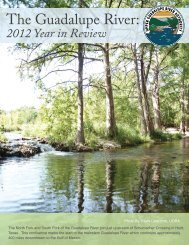Acronym Dictionary - Upper Guadalupe River Authority
Acronym Dictionary - Upper Guadalupe River Authority
Acronym Dictionary - Upper Guadalupe River Authority
Create successful ePaper yourself
Turn your PDF publications into a flip-book with our unique Google optimized e-Paper software.
SOP – Standard Operating Procedure: A set of instructions outlining the step by step process<br />
needed to accurately complete sample analysis or collection. All UGRA lab technicians are<br />
trained to follow the SOPs for the testing they conduct.<br />
SWQM – Surface Water Quality Monitoring: A Texas Commission on Environmental Quality<br />
(TCEQ) program that monitors the quality of surface water to evaluate physical, chemical, and<br />
biological characteristics of aquatic systems. Water quality is monitored in relation to human<br />
health concerns, ecological condition, and designated uses. The data collected under this<br />
program provides a basis for effective policies that promote the protection, restoration, and wise<br />
use of surface water in Texas.<br />
SWQMIS – Surface Water Quality Monitoring Information System: The Texas Commission on<br />
Environmental Quality (TCEQ) database that stores surface water quality data used for<br />
monitoring and assessment. Data must meet specific objectives outlined in the Quality<br />
Assurance Project Plan (QAPP) in order to be included in SWQMIS<br />
TCEQ – Texas Commission on Environmental Quality: The environmental agency for the State<br />
of Texas regulating air, water, and the safe management of wastes.<br />
TD – Technical Director: A laboratory position with specific qualifications outlined by the<br />
National Environmental Accreditation Conference (NELAC). All NELAC certified labs must<br />
maintain at least one qualified Technical Director and Deputy TD.<br />
TMDL – Total Maximum Daily Load: A calculation of the maximum amount of a pollutant that<br />
a water body can receive and still safely meet water quality standards. Section 303(d) of the<br />
Clean Water Act requires states to develop lists of impaired waters. These are waters that are too<br />
polluted or otherwise degraded to meet the water quality standards set by the states. Once a<br />
water body is listed as impaired, the law requires that the states develop TMDLs for these waters.<br />
A four miles reach of the <strong>Upper</strong> <strong>Guadalupe</strong> <strong>River</strong> in Kerrville was listed as impaired due to high<br />
E. coli bacteria levels in 2002 and a TMDL was adopted in 2007.<br />
TMDL-IP – Total Maximum Daily Load – Implementation Plan: Once a TMDL is adopted by<br />
the state and EPA, a plan must be developed to identify the pollution reduction strategies<br />
necessary to achieve the desired load reductions and a detailed plan for implementation. The<br />
Texas Commission on Environmental Quality (TCEQ) is responsible for developing the<br />
implementation plan. UGRA received a three-year grant under section 319 of the Clean Water<br />
Act to develop an implementation plan at the local level in conjunction with a local stakeholder<br />
group.<br />
TNI – The NELAC Institute: A 501(c)(3) non-profit organization whose mission is to foster the<br />
generation of environmental data of known and documented quality through an open, inclusive,<br />
and transparent process that is responsive to the needs of the community. TNI provides guidance<br />
for the NELAC certification process.<br />
TPDES – Texas Pollutant Discharge Elimination System: A regulatory program to control<br />
discharges of pollutants to surface waters. The state of Texas assumed the authority to<br />
Updated 11/25/2009<br />
Access digital version at http://www.ugra.org/pdfs/<strong>Acronym</strong><strong>Dictionary</strong>.pdf



